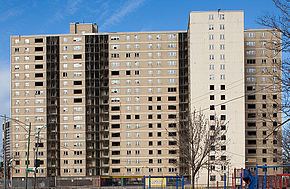Status Demolished Demolished 1996–2007 | Constructed 1955–58 | |
 | ||
Location Bounded by 35th Street and Pershing Road and Federal and State Streets.Chicago, Illinois United States GoverningBody | ||
The last stateway gardens highrise awaits its fate
Stateway Gardens was a Chicago Housing Authority (CHA) public housing project located in the Bronzeville neighborhood of the South Side of Chicago, Illinois, United States. It was located alongside the Dan Ryan Expressway, adjacent to the former Robert Taylor Homes. Stateway Gardens was a part of the State Street Corridor which included other CHA properties: Robert Taylor Homes, Dearborn Homes, Harold Ickes Homes and Hillard Homes. Stateway Gardens was home to people living in mid- and high-rise apartment buildings. Over the years, gang violence and neglect created terrible conditions for the residents in Stateway.
Contents
- The last stateway gardens highrise awaits its fate
- The last stateway gardens highrise demolition part 3
- Construction
- Problems and crime
- Re Organization
- Demolition
- References
The last stateway gardens highrise demolition part 3
Construction
In 1955, construction at Stateway Gardens began, with 1,644 units planned in eight high-rise buildings. The total cost for the project was $22 million. Three years later, construction was complete and approximately 3,000 people moved in. In 1978, a major CHA renovation plan costing $106.2 million was undertaken. This project rehabilitated Stateway Gardens, Robert Taylor Homes and most of the ABLA Homes on Chicago's Near West Side.
Problems and crime
In August, 1984, Stateway Gardens was within the six poorest U.S. census tracts, according to a Roosevelt University study. Cabrini–Green on the North Side ranked seventh in the same study. Amid rising crime in CHA developments in the early 1980s, the Chicago Police Department launched a Public Housing Crime Unit to replace private security guards at those sites. In 1988, (prior to the forming of the CHA Police Department) the South Side's Wentworth Police District (which included Stateway Gardens and the Robert Taylor Homes) had 67 homicides, the highest of any district in the city. Stateway Gardens was infamous for its high rate of violent crime and drug activity through the late 1990s.
Re-Organization
The federal government created Housing Opportunities for People Everywhere (known as HOPE VI) in 1993 as a way to provide funds for cities to demolish dilapidated public-housing units and replace them with mixed-income communities. In 1995, federal officials seized control of all Chicago Housing Authority holdings and property amid allegations of corruption and graft. Four years later, the CHA successfully left federal receivership.
Demolition
In 1996, demolition of Cabrini–Green began. This marked the start of what eventually came to be known as the Chicago Housing Authority's Plan for Transformation. One year later, demolition began at the Robert Taylor Homes. In 2000, the CHA formally approved the 10-year Plan for Transformation to remake public housing and demolition began at Stateway Gardens. In October 2006, families living in the last remaining building (3651–53 S. Federal St.) at Stateway Gardens were scheduled to leave. The building was finally demolished in June 2007, making way for Phase 1 of the mixed income development Park Boulevard, half of which was already completed prior to the demolition and resident relocation processes. The CHA used its One Strike department to determine who would be getting Section 8 for relocation. The One Strike department was set up to minimize the amount of tenants who would qualify movement into CHA's newly built homes.
